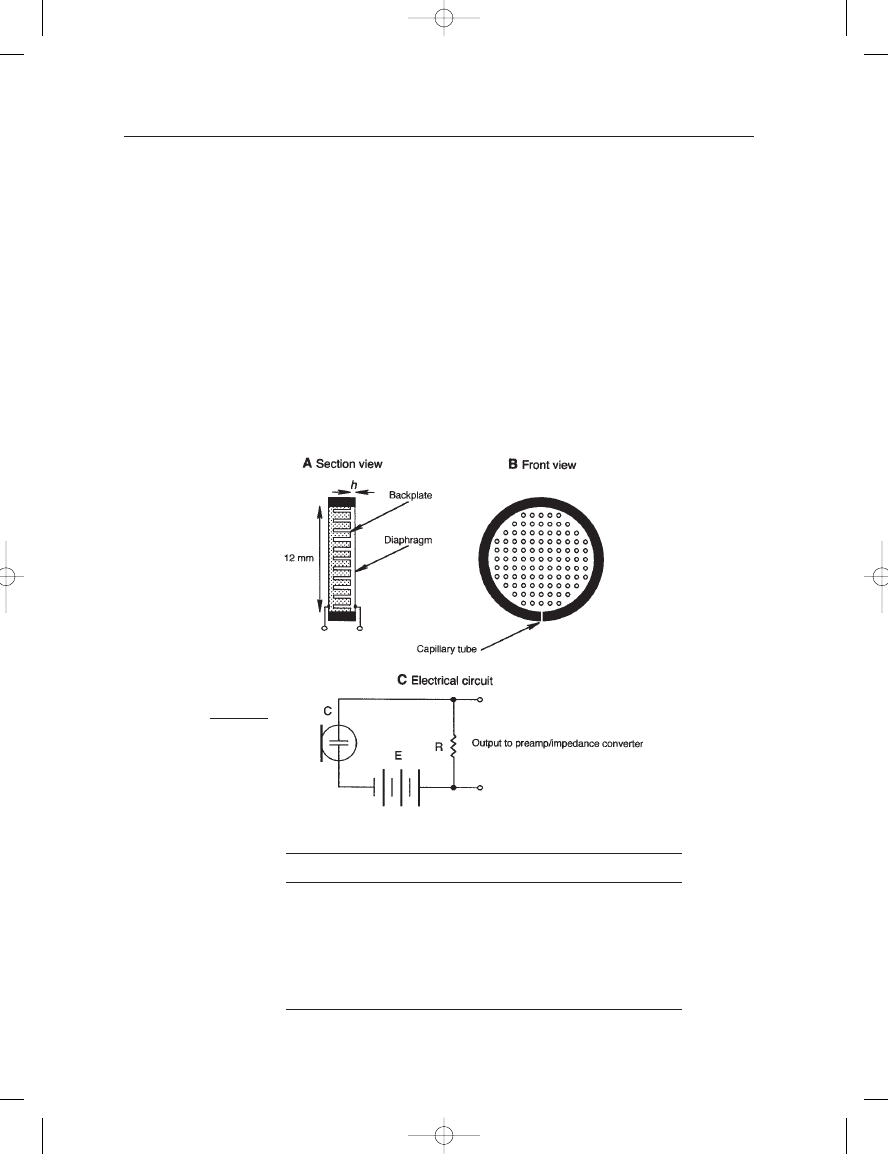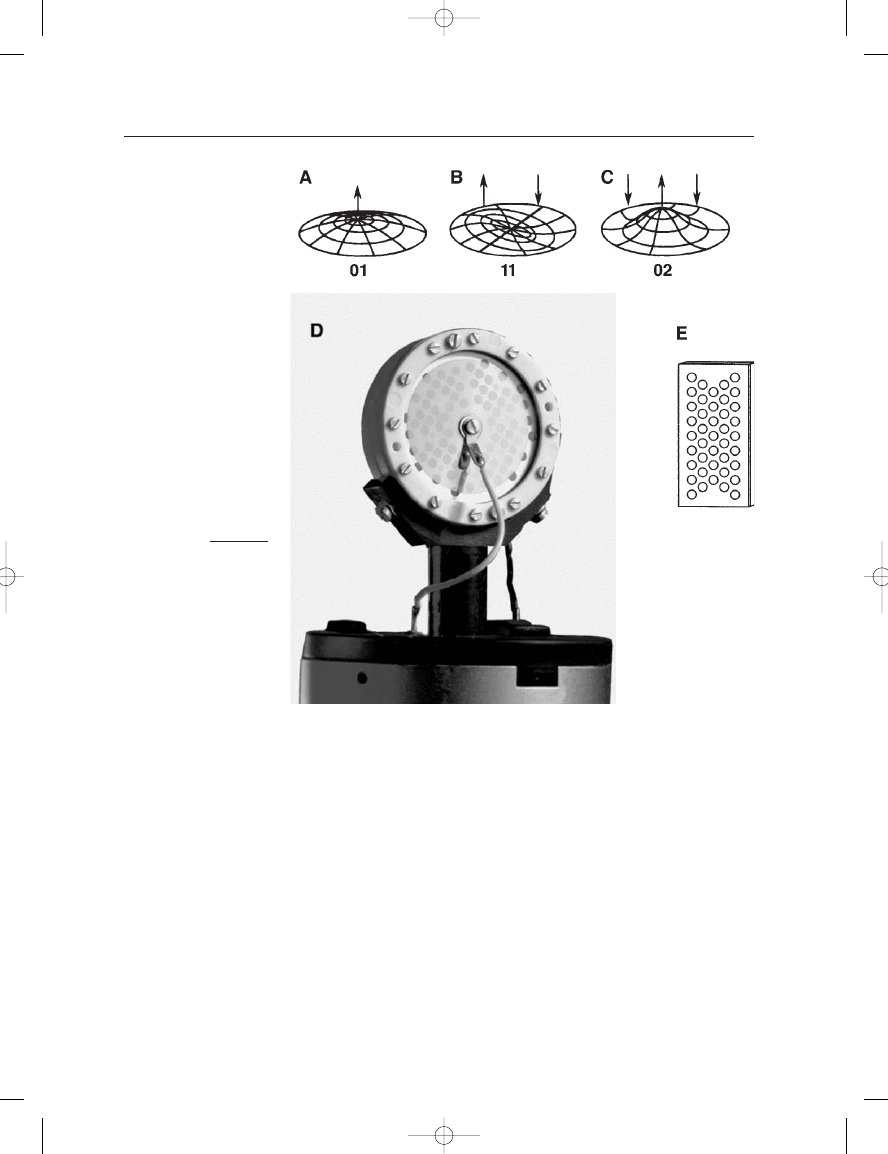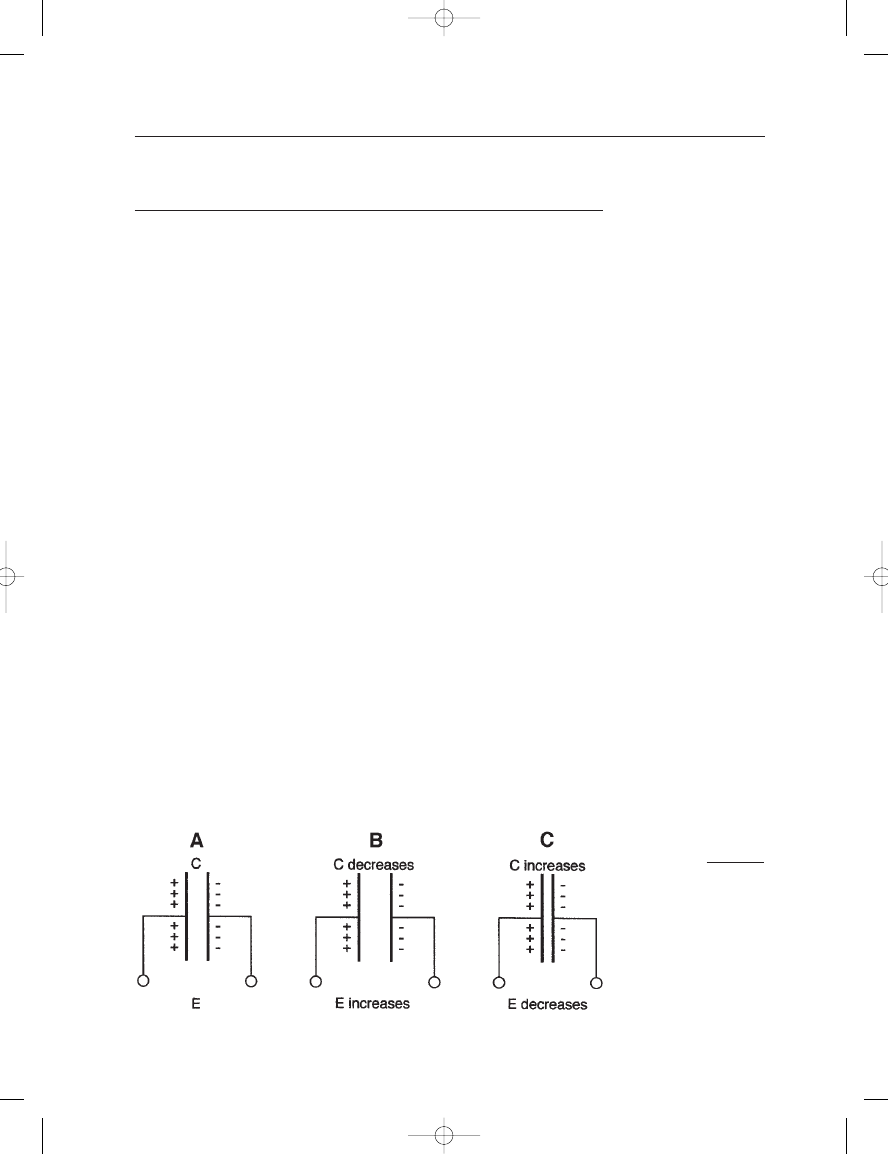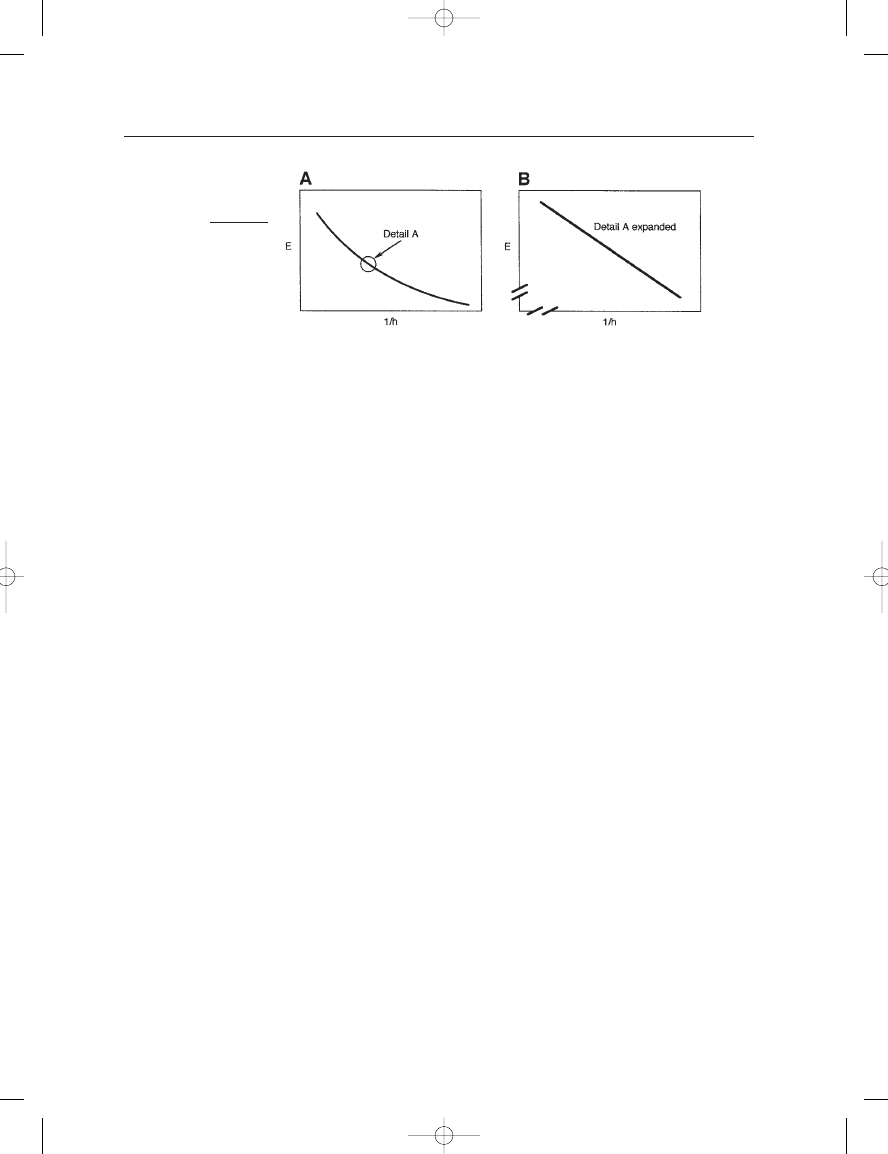ВУЗ: Казахская Национальная Академия Искусств им. Т. Жургенова
Категория: Книга
Дисциплина: Не указана
Добавлен: 03.02.2019
Просмотров: 17242
Скачиваний: 51

Wente model. General dimensions and relative signal values for a typical
12.7 mm (0.5 in) diameter capacitor pressure microphone are:
1. Dimension h is about 20 mm (0.0008 in).
2. Peak-to-peak diaphragm displacement for a 1 Pa rms sine wave sig-
nal (94 dB L
P
) is about 1
10
8
m.
3. The static capacitance of the capsule is about 35 pF.
4. For a dc polarizing voltage on the diaphragm of 60 V, the signal
voltage generated by the 1 Pa acoustical signal is about 12 Vrms at
the capacitor’s terminals before preamplification.
Table 3–1 indicates the peak diaphragm displacement as a function
of pressure level. For the sake of example, let us multiply the microphone’s
dimensions by 1 million. The microphone now is 12 km in diameter, and
3: The Pressure Microphone
23
FIGURE 3–1
Details of a 12 mm diameter
capacitor microphone:
section view (A); front
view (B); simplified
electrical circuit (C).
TABLE 3–1
Peak diaphragm displacement relative to pressure level
Level (dB L
P
)
Peak-to-peak displacement (m)
14
10
12
34
10
11
54
10
10
74
10
9
94
10
8
114
10
7
134
10
6
Earg_03.qxd 14/9/04 2:37 PM Page 23

the distance from the backplate to the diaphragm is 20 m. For L
P
of
94 dB, the peak-to-peak displacement of the diaphragm is about 10 mm.
Using the same model, the peak diaphragm displacement at 134 dB L
P
is
about 1 m, representing a
5% variation in spacing between the back-
plate and diaphragm. This exercise aptly demonstrates the microscopic
nature of the capacitor microphone’s diaphragm motion at normal
sound levels.
PHYSICAL DETAILS OF THE CAPACITOR PRESSURE MICROPHONE
The very small holes in the backplate (Figure 3–1B) are evenly distrib-
uted on a uniform grid. During the actual back and forth motion of
the diaphragm, the air captured in the holes provides damping of the
diaphragm’s motion at its principal resonance, which is normally in the
range of 8–12 kHz. The diaphragm is usually made of a thin plastic
material, typically Mylar, on which has been deposited a molecular-thin
layer of metal, often gold. Aluminum, nickel, and titanium also have
been used as diaphragm materials.
Operating in parallel with the tension of the diaphragm itself is the
added stiffness provided by the captured air behind the diaphragm. Both
of these are necessary to maintain the high resonance frequency of the
diaphragm assembly. A very small capillary tube connects the interior air
mass to the outside, providing a slow leakage path so that static atmos-
pheric pressure will equalize itself on both sides of the diaphragm under
all atmospheric conditions. The polarizing circuitry is shown at C.
One early notable capacitor microphone model, the Altec-Lansing
21C, used a very thin 50
m (0.002 in) gold sputtered glass plate in
place of the normal flexible diaphragm. The inherent stiffness of the glass
plate required no additional tension to attain a suitably high-resonance
frequency.
DIAPHRAGM MOTION
While we customarily speak of a capacitor microphone’s diaphragm as
having a single degree of freedom, the actual motion over most of the
frequency range resembles that of an ideal drum head, as shown in
exaggerated form in Figure 3–2A. It is intuitively clearer and mathe-
matically simpler to think of the diaphragm as a rigid piston. If we take
the center of the diaphragm as our reference displacement value, it is
obvious that the outer portions of the diaphragm exhibit less displace-
ment. Wong and Embleton (1994) show that the effective area of an
equivalent rigid piston is one that has an area one-third that of the
actual diaphragm.
As the circular edge-supported membrane vibrates at higher fre-
quencies, its motion no longer is simple. Motions influenced by radial
and tangential modes in the diaphragm, such as those shown in
Figures 3–2B and 3–2C begin to appear, and the microphone’s amplitude
THE MICROPHONE BOOK
24
Earg_03.qxd 14/9/04 2:37 PM Page 24

response becomes erratic. As a general rule, radial modes become pre-
dominant only above the normal frequency range of the microphone.
Figure 3–2D shows details of Neumann’s back-to-back diaphragm
assembly with its characteristic center and rim clamping arrangement.
Obviously, this diaphragm has a completely different set of motions than
those of the simple rim supported diaphragm. Figure 3–2E shows a rec-
tangular diaphragm structure, with yet another set of motions at high
frequencies. A diaphragm of this type is normally about 12 mm (0.5 in)
wide and about 38 mm (1.5 in) high.
An important design variation is used by Sennheiser Electronics, and
that is the practice of not increasing the diaphragm tension to maintain
flat response at high frequencies. Instead, flat response is obtained by
electrical boosting of the diaphragm’s output at HF to whatever degree
is required.
3: The Pressure Microphone
25
FIGURE 3–2
Complex diaphragm
vibration due to radial and
tangential modes: normal
motion (A); mode 11 (B);
mode 02 (C); Neumann
center-clamped assembly
(D); rectangular assembly as
used by Pearl Microphone
Laboratories (E). (Photo
courtesy Neumann/USA.)
Earg_03.qxd 11/10/04 3:40 PM Page 25

ELECTRICAL DETAILS OF THE CAPACITOR PRESSURE
MICROPHONE
The capacitor microphone operates on the static relationship
Q
CE
(3.1)
where Q is the electrical charge (coulombs) on the plates of a capacitor,
C is the capacitance (farads), and E is the applied dc voltage. In the
capacitor microphone, the backplate and diaphragm represent the two
plates of the capacitor.
Figure 3–3 shows a capacitor with variable spacing between the two
plates. The capacitor at A is charged by applying a reference dc voltage, E,
across it; and a charge, Q, is produced on the plates. Now, if the plates are
separated slightly, as shown at B, the capacitance is reduced. The charge
remains fixed, however, and this causes the voltage, E, to rise. This comes
as a consequence of satisfying equation (3.1). Alternatively, if we move the
plates closer together, as shown at C, the capacitance increases and the
voltage drops.
In the externally charged capacitor microphone, the applied polariz-
ing voltage is fed through a very high resistance, as in the network shown
in Figure 3–1C. The series resistance of 1 G
(10
9
ohms) ensures that,
once the charge is in place, normal audio frequency variations in the
diaphragm’s displacement do not alter the charge but are manifest as a
variation in voltage, which is the inverse of the change in capacitance.
For our analysis here, we assume that negligible power is transferred
between the capacitor and the resistor.
It is important that the value of the polarizing voltage be well below
the break-down voltage of the air dielectric in the capacitor capsule. This
value is approximately equal to 3000 V/mm under normal atmospheric
conditions. Studio-grade capacitor microphones typically are polarized
in the range of 48–65 volts, while instrumentation microphones may
operate in the range of 200 V. A slight electrostatic attraction between
the diaphragm and backplate is caused by the polarizing voltage, which
causes the diaphragm to be drawn very slightly toward the backplate.
THE MICROPHONE BOOK
26
FIGURE 3–3
Relationships in a charged
capacitor: a fixed charge is
placed on the plates of a
capacitor (A); reducing the
capacitance causes the
voltage to increase (B);
increasing the capacitance
causes the voltage to
decrease (C).
Earg_03.qxd 14/9/04 2:37 PM Page 26

For a fixed charge, the basic polarizing voltage versus capacitance
relationship is not truly a linear one. When viewed over a wide range of
capacitance change, the relation is hyperbolic, as shown in Figure 3–4A.
However, over the normally small displacement range, as shown at B,
the relationship is very nearly linear. Recall from the section above on
Analysis of the Capacitor Pressure Microphone that normal diaphragm
motion is extremely small; only for signals in the range of 130 dB L
P
and greater is the diaphragm displacement in the 5% range relative to its
distance from the backplate, and this represents a change in position of
only 1 part in 20.
Shielding the microphone is very important since the high electrical
impedance of the polarizing network makes the system susceptible to
electrostatic interference. Normally, a grounded metal mesh screen sepa-
rates the diaphragm assembly from the outside and provides the neces-
sary shielding.
REGION OF FLAT ELECTRICAL OUTPUT
The value of capacitance depends on, among other things, the displace-
ment of one plate relative to the other. Therefore, for uniform (flat) elec-
trical output from the capacitor element, the diaphragm displacement
should be independent of frequency. In a plane progressive wave, pres-
sure and particle velocity are in phase with each other, as discussed in
Chapter 2. The relationship between air particle displacement and veloc-
ity is given by the integral of u(t) with respect to time:
(3.2)
where x(t) is the instantaneous particle displacement and u(t) is the
instantaneous particle velocity. For a sinusoidal signal, u(t) is of the form
e
j
t
; therefore,
(3.3)
This equation describes a response that is inversely proportional to
frequency (i.e., rolls off at 6 dB per octave with increasing frequency).
x(t)
u(t)dt
(
j/)e
j
t
x(t)
u(t)dt
3: The Pressure Microphone
27
FIGURE 3–4
Nonlinearity of
capacitance versus
displacement (A); for a very
small displacement, the
relationship is virtually
linear (B).
Earg_03.qxd 14/9/04 2:37 PM Page 27